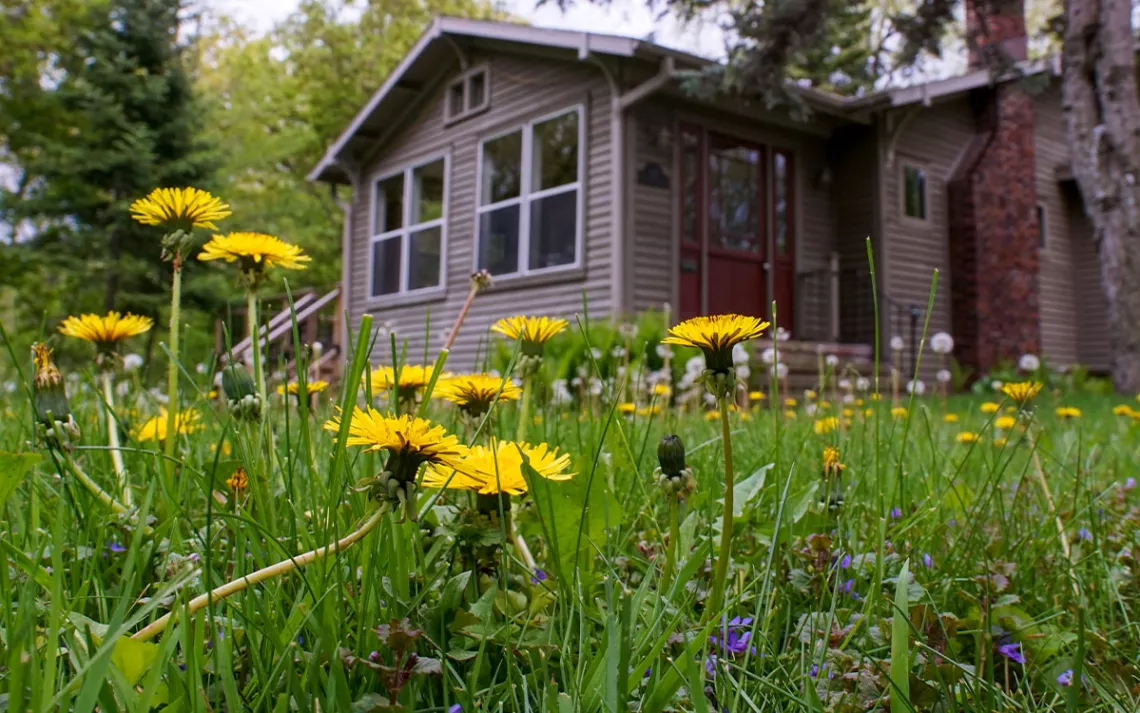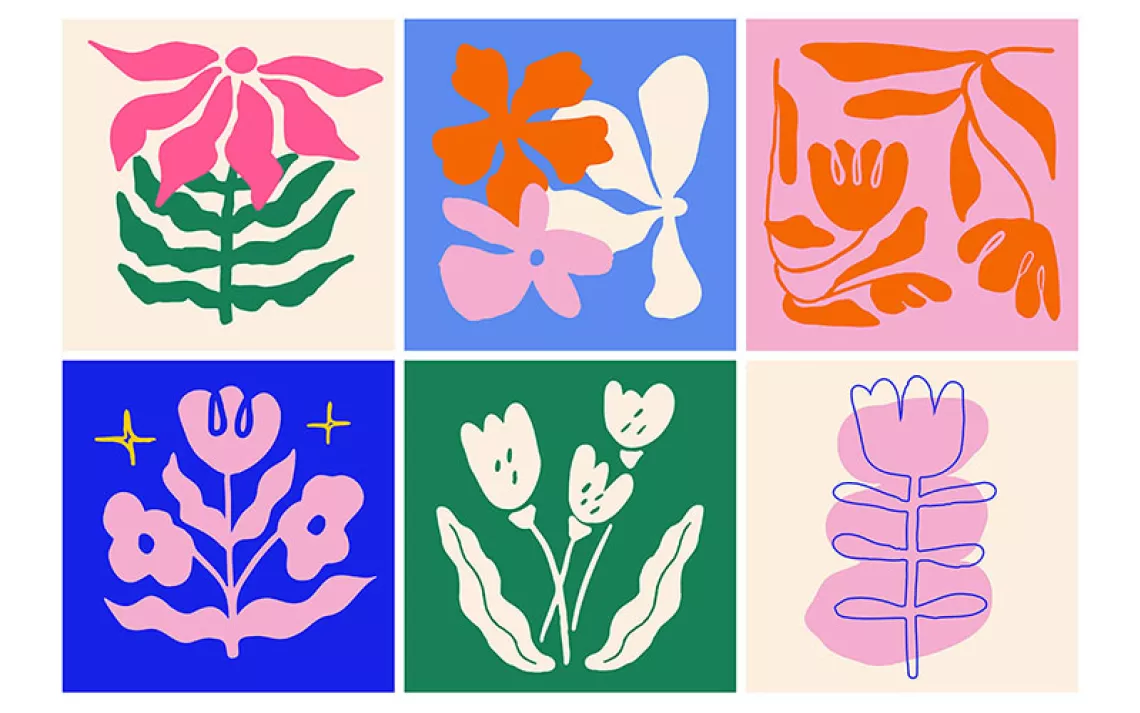Blossoms Over Blades: Embrace "Slow Mow Summer" for a Buzz-Worthy Lawn
If you’re a fan of No Mow May, you’re going to love Slow Mow Summer

Dandelions and creeping Charlie grow in an unmowed yard in Appleton, Wisconsin. | Photo by Anne Readel
>No Mow May is a wildly popular movement for pollinator conservation. Its appeal lies in its simplicity and accessibility—by not mowing your lawn in May, you allow lawn flowers to bloom, providing crucial food for pollinators waking from hibernation. At first glance, it seems perfect—you can support pollinators by doing nothing for an entire month! However, the movement has some notable drawbacks.
>While No Mow May raises awareness about pollinator conservation, its benefits are limited to just one month. Additionally, the timing may not align with when bees emerge from hibernation across different regions. And cutting down a month’s growth all at once can be detrimental to lawn health. The appearance of tall, unkempt grass—which can grow to over a foot high during the month of May—is also not welcomed by all.
To address these issues, several spinoff initiatives have emerged, such as No Mow April, Low Mow May, Low Mow Spring, and Slow Mow Summer.
Among these, Slow Mow Summer stands out as particularly promising. Launched in 2023, this initiative stems from a collaboration among scientists at the University of Minnesota’s Bee Lab and Turfgrass Science Lab, and James Wolfin, a conservation specialist at Twin City Seed. “No Mow May has the absolute best intentions and goals in mind, but it’s not necessarily the best way to achieve those goals,” says Wolfin.
Slow Mow Summer is straightforward—by allowing your lawn to grow longer and mowing less frequently throughout the season, you enable lawn flowers to flourish. “By having flowers available in lawns, you’re able to support a variety of pollinating insects that will visit those flowers to collect nectar and pollen,” says Elaine Evans, a University of Minnesota extension educator and bee researcher.
This new initiative is not only beneficial for pollinators but also the health of your turfgrass. “There’s so much data out there that suggests that if you let your lawn grow taller, you will create a deeper root system and create a more resilient lawn. That will also mean you’re mowing less frequently,” says Wolfin. As an added benefit, you’re reducing your carbon footprint by not firing up your lawn mower as often.
To practice Slow Mow Summer, Jon Trappe, a University of Minnesota turfgrass extension educator, recommends keeping your lawn at least three and a half inches tall. To accomplish this, you can allow your grass to grow six inches tall before cutting it down to four inches. If your mower can’t handle that height, you can let it grow to five inches before cutting it down to 3.5 inches. Many lawn flowers—such as white clover—will start to bloom at three inches in height, notes Wolfin. So by following these mowing recommendations, you should always have some blossoms present in your yard.
These guidelines also align with the “one-third rule” in lawn care, which recommends never mowing more than one-third of grass in a single mowing session. Cutting more than this—like what is often done at the end of No Mow May—can stress grass and increase its vulnerability to weeds, erosion, and drought. Trappe also recommends leaving lawn clippings in your lawn after mowing to return nutrients, such as nitrogen, to your soil.
Of course, if you’re going to try to support flowers and bees in your yard, lay off the herbicides and pesticides. “Herbicides are going to be eliminating any of those flowering plants that you want to have growing,” says Evans. “You also want to be mindful to not have flowers that you’re providing be contaminated with pesticides, insecticides, or fungicides that could be harmful to pollinators.”
Slow Mow Summer is not just a catchy slogan; it’s also grounded in compelling research. In Springfield, Massachusetts, the third-largest city in the state, researchers explored how different mowing frequencies impacted the number of flowers and bees in lawns. They subjected homes to three different mowing schedules: weekly, bi-weekly, and every three weeks. They then counted the number of blooming flowers and bees in their lawns throughout the summer.
The research revealed a surprisingly rich diversity of flowers and bees in lawns. “When you look out at [lawns], you think there’s really nothing there and that they’re not really providing any habitat,” says Susannah Lerman, a research ecologist at the US Forest Service who led the study. However, looks can be deceiving. Lerman and colleagues identified 63 species of plants growing spontaneously in yards and 111 species of bees, which represented almost a quarter of all bee species recorded in Massachusetts. “The amount of diversity was astonishing,” says Lerman.
Also contrary to expectations, taller lawns with more flowers did not attract more bees. “What we found is that the yards that were mowed every three weeks had more lawn flowers, but the yards that were mowed every two weeks had the most bees,” says Lerman. She believes that the tall grass in lawns mowed every three weeks made it harder for bees to access flowers. Thus, mowing every two weeks was the sweet spot for allowing lawn flowers to bloom, attracting bees to those flowers, and maintaining a tidy lawn appearance.
Lerman stresses to Sierra that even though her study was conducted in a suburban area, she says, “this isn’t a suburban issue; this is a lawn issue.” All lawns—suburban or rural—can be important for supporting biodiversity. The “lazy lawnmower” approach recommended by Lerman’s research was important in the development of Slow Mow Summer, says Wolfin.
While No Mow May remains popular, interest in Slow Mow Summer has grown, according to Trappe. In some places, Slow Mow Summer is ousting No Mow May. Elizabeth Braatz, an insect ecologist at the Wisconsin Department of Natural Resources, learned of Slow Mow Summer last year from a fellow scientist. At the time, she had received numerous queries about No Mow May and wanted to make sure she was providing comprehensive advice. Her contact introduced her to the newly minted Slow Mow Summer initiative. When Braatz looked into it further, she liked what she saw. “It’s a more sustainable practice to recommend,” she says.
Braatz believes that No Mow May has been great for getting people to think about backyard conservation and expand their perception of lawn beauty. “It’s gotten the conversation started. However, that doesn’t mean that the first idea we come up with as we start these conversations is necessarily going to be the most sustainable from a management perspective,” she says.
When the Conservation Committee for the Village of Shorewood, Wisconsin, reached out to Braatz about issues they were having with No Mow May, she recommended Slow Mow Summer. According to Linda Frank and Joey Sprague, both members of the committee, there was a lot of enthusiasm for No Mow May in 2023. “We calculated roughly 30 percent of the residential yards in our community were unmowed. And that doesn’t count maybe another 5 to 10 percent of yards that didn’t have any turf grass to mow to begin with,” says Sprague. Regardless, the Village received numerous complaints about the tall grass. Committee members were also concerned with continuing No Mow May due to its known shortcomings. So this year, they’re asking people to first try “Slow Mow May” by letting grass grow to six inches and then cutting it back to four inches throughout the month of May. They then recommend that people continue with a full Slow Mow Summer.
Slow Mow Summer is just one of many options that people can do to help pollinators in their yards. “We like to give people lots of options,” says Evans. “Slow Mow Summer is one of the easier things you can do.” For those who have more time and energy, she recommends installing a bee lawn or planting a pollinator garden with a diversity of native plants that bloom from spring through fall. Leaving the leaves and stems in your yard and delaying spring cleanup also provides habitat for pollinators.
Our yards provide an incredible opportunity to help bees, stresses Lerman. With roughly 30 percent of the continental United States made up of residential yards, “there’s so much opportunity and potential for creating more wildlife habitat,” she says. “Everybody can do something.”
 The Magazine of The Sierra Club
The Magazine of The Sierra Club



